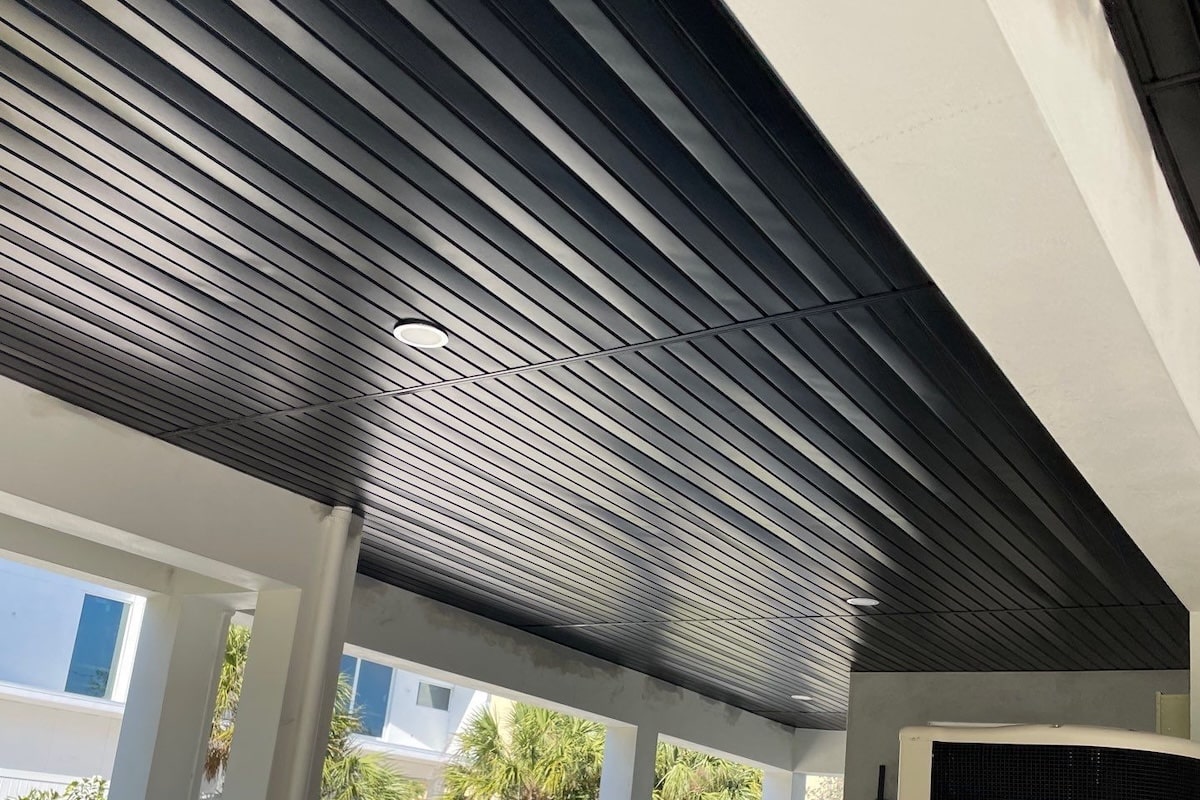When most homeowners think about roof protection, they picture shingles, flashing, or gutters. But the hidden edges of your roofline—the soffit and fascia—play a silent yet critical role in keeping your home structurally sound. Without proper coverage, moisture seeps into your roof deck, pests sneak into your attic, and poor ventilation causes mold and rot. Soffit and fascia are more than aesthetic trim—they’re essential guardians of your home’s most exposed areas.
In this guide, you’ll learn everything you need to know about soffit and fascia: what they are, how they function, common warning signs of damage, and the benefits of quality installation. We’ll cover the materials available, key tips for long-term care, and how professional service can protect your roof for decades. Whether you’re a homeowner planning exterior updates or tackling persistent attic moisture, this comprehensive resource is for you.
At SunLife Gutters and Homes, we provide expert soffit and fascia installation and repair across Southwest Florida. With every project, we help homeowners protect their roofline, improve energy efficiency, and enhance their home’s curb appeal. Request a Free Estimate or Visit Us in Person to learn how we can help.
What Are Soffit and Fascia?
These two components are often overlooked, but they’re essential to your roof’s overall performance and appearance. Let’s break down what they are, where they’re located, and why they matter.
Soffit Defined: The Underside of Roof Overhangs
The soffit is the exposed surface beneath the roof’s overhanging eaves. It’s typically made from vinyl, aluminum, or wood, and it serves a critical function: ventilation. Properly vented soffits allow fresh air into your attic, preventing heat and moisture buildup that can lead to mold, rot, or ice damming in colder climates.
Fascia Explained: The Roofline’s Front Guard
The fascia is the vertical finishing edge that connects the roof to the soffit. It runs along the roof’s perimeter and holds the gutters in place. Fascia boards protect the edge of the roof deck from moisture, pests, and other elements while also creating a clean, polished look.
Why These Components Work Together
Soffit and fascia operate as a system. The soffit brings air into the attic, while the fascia acts as a barrier between the elements and your home’s interior structure. When either component is damaged or missing, it can compromise your entire roofing system.
The Benefits of Soffit and Fascia
Investing in high-quality soffit and fascia does more than improve your home’s appearance—it helps protect your structure from long-term damage and boosts energy efficiency.
Structural Protection from Moisture and Pests
Fascia boards shield your roof’s edge from water infiltration, while soffits close off exposed eaves that would otherwise be open to birds, squirrels, and insects. Together, they create a sealed, durable perimeter that guards against costly decay and infestations.
Improved Attic Ventilation and Energy Efficiency
Ventilated soffits allow continuous airflow into the attic, which reduces moisture buildup and helps regulate indoor temperatures. This is especially important in Florida’s hot, humid climate where trapped attic heat can overwork your HVAC system.
Enhanced Curb Appeal
Soffit and fascia give your roof a clean, finished look that can enhance the architectural design of your home. With a variety of colors and materials available, they’re also an opportunity to elevate your exterior style.
Gutter Support and Water Management
Fascia boards provide the anchoring point for your gutter system. A strong, straight fascia ensures your gutters remain firmly in place, helping divert rainwater away from your foundation and landscaping.
Common Signs of Soffit and Fascia Damage
Over time, soffit and fascia can deteriorate due to weather, pests, or neglect. Recognizing the early warning signs can help you avoid major repairs down the line.
Peeling Paint or Discoloration
If you notice paint bubbling, cracking, or peeling along the roofline, it’s often a sign that moisture has penetrated the fascia or soffit. Discoloration—especially black, brown, or green streaks—can also point to mold or mildew growth.
Visible Rot or Sagging Sections
Soft, crumbling wood or sagging panels are red flags for wood rot. These areas may feel spongy to the touch or appear warped. In severe cases, pieces may begin to detach completely from the roofline.
Insect or Animal Activity
If you hear scratching or see signs of nesting near the eaves, there may be an entry point through a damaged soffit. Squirrels, birds, and insects commonly exploit weak spots to get into attic spaces.
Water Stains in the Attic or Along Interior Walls
Moisture that gets past the fascia can travel into the attic and down your walls. If you notice watermarks, mold, or a musty smell inside your home, your soffit and fascia might be the hidden culprits.
Learn more in “Signs You Need Fascia Repair”
Choosing the Right Soffit and Fascia Materials
The materials you choose for soffit and fascia impact not only durability but also ventilation, maintenance, and curb appeal. Let’s look at the most common options and their pros and cons.
Vinyl: Affordable and Low-Maintenance
Vinyl soffit and fascia are popular because they resist rot, insects, and peeling paint. They’re easy to clean and come in various colors and styles. While not as strong as metal, vinyl is a great option for budget-conscious homeowners who want long-lasting protection.
Aluminum: Lightweight and Rust-Resistant
Aluminum is ideal for Florida’s humid climate. It won’t warp or crack from heat, and it’s resistant to rust and moisture. It’s also paintable and often used in vented soffit panels for maximum airflow.
Wood: Traditional but High-Maintenance
Wood fascia and soffit offer a classic look and can be stained or painted to match any home. However, they require frequent maintenance and are vulnerable to rot, especially in damp environments. Not recommended unless you’re committed to regular upkeep.
Composite or Engineered Wood: A Modern Upgrade
Made from a mix of wood fibers and resins, composite fascia boards offer the look of real wood without the high maintenance. They’re water-resistant, durable, and often come pre-primed for easy painting.
Need help deciding? Explore “Choosing the Best Soffit Material for Your Home”
Soffit and Fascia Installation & Replacement: What to Expect
Proper installation of soffit and fascia is key to protecting your home’s roofline and ensuring long-term performance. Whether you’re replacing damaged components or installing them for the first time, here’s what the process involves.
Inspection and Preparation
A professional starts by assessing the existing structure—checking for water damage, wood rot, and pest infestations. Damaged areas are removed and the surface is cleaned and prepped to ensure a secure installation.
Material Customization and Cutting
Soffit panels and fascia boards are cut to fit the exact dimensions of your roofline. Vented soffit is used in areas that require airflow, while solid panels may be placed in less critical areas for a seamless look.
Installation of Soffit Panels
Soffits are installed beneath the eaves, usually secured to wood framing using nails or screws. For vented soffit, careful attention is paid to spacing and alignment to maintain airflow without gaps for pests to enter.
Mounting the Fascia Boards
Fascia boards are fastened along the edge of the roofline, covering the ends of the rafters and supporting the gutters. Flashing may be installed behind the fascia to prevent water from sneaking in behind it.
Final Sealing and Gutter Reattachment
Caulking and sealant are applied where needed to ensure a tight fit. Gutters are then reattached securely to the fascia boards, completing the system.
Soffit and Fascia Maintenance Tips
Routine maintenance helps preserve the appearance and functionality of your soffit and fascia while extending their lifespan. Here’s how to keep them in excellent shape year-round.
Seasonal Inspection Checklist
- Spring/Fall Checkups: Inspect for rot, cracks, or pest entry points.
- Paint and Finish: Look for peeling paint or faded finishes, especially with wood or aluminum.
- Vent Openings: Ensure soffit vents are clear of dirt, insulation, or nests.
- Fascia Integrity: Check gutter attachment points and fascia edges for separation or softness.
Cleaning and Upkeep
Use a soft-bristle brush or pressure washer on a low setting to clean vinyl and aluminum soffits. Avoid harsh chemicals that can strip paint or damage the surface. Wood components should be cleaned gently, dried thoroughly, and resealed every few years.
Preventing Common Issues
- Install Gutter Guards: Keeps fascia dry by preventing overflow and clogs.
- Trim Nearby Trees: Reduces debris buildup and pest access to roof eaves.
- Upgrade to Durable Materials: Composite and aluminum require less upkeep and last longer.
Looking for a full checklist? Visit “Soffit & Fascia Maintenance Guide”
Frequently Asked Questions About Soffit and Fascia
How long do soffit and fascia last?
It depends on the material and climate. Vinyl and aluminum systems can last 20–30 years with minimal maintenance, while wood typically requires replacement or refinishing every 10–15 years.
Do all homes have soffit and fascia?
Most modern homes do, but some older or custom-built houses may lack a defined overhang or finishing trim. Adding soffit and fascia can improve both function and aesthetics.
How much does soffit and fascia replacement cost?
Costs vary based on material and house size, but on average, homeowners can expect to spend $6–$10 per linear foot installed. Wood and composite materials tend to be more expensive than vinyl.
Can soffit and fascia be painted?
Yes. Wood and aluminum can be painted to match your home, while many vinyl products come in pre-finished colors that don’t require painting.
Ready to Protect Your Roof’s Edges the Right Way?
Soffit and fascia may not always be visible, but they play a critical role in your home’s defense against weather, moisture, and pests. Upgrading or maintaining them is one of the smartest moves you can make to protect your roofing system—and your investment.
At SunLife Gutters and Homes, we offer expert soffit and fascia installation and repair backed by years of hands-on experience in Florida’s climate. Whether you need routine maintenance, a full replacement, or help choosing the best materials for your home, we’re here to help.
Request Your Free Estimate or Visit Us in Person today to get started.

